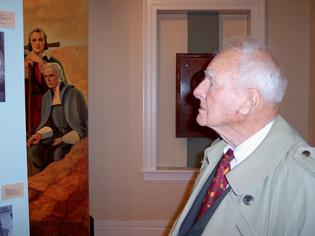
“I remember the WPA projects,” reminisced New Haven native Henry Townsend Thursday night at the opening of the New Haven Museum’s exhibition on the local impact of the Federal Arts Project. “Those were pretty desperate times. I was very enthusiastic about the projects. For the artists, it gave them something to do in their profession. Of course a lot of it was make-work, but it drummed up activity.”
p(clear). 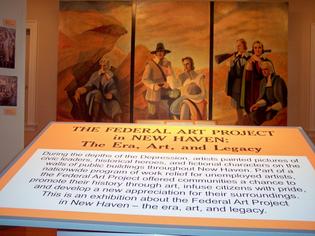 During a six-month period between December 1933 and June 1934, New Haven participated in a federally funded relief program that put local artists back to work. The city was quick to embrace the new Public Works for Art Program (PWAP), the first of a series of programs that eventually grew into the Federal Art Project of the Works Project Administration (FAP/WPA).
During a six-month period between December 1933 and June 1934, New Haven participated in a federally funded relief program that put local artists back to work. The city was quick to embrace the new Public Works for Art Program (PWAP), the first of a series of programs that eventually grew into the Federal Art Project of the Works Project Administration (FAP/WPA).
p(clear). 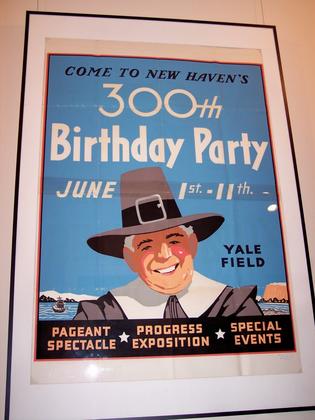 Under the PWAP, local artists were given $35 a week to create murals and sculptures that would “take the snobbery out of art and make it a part of the daily life of the average citizen,” according to the program’s proponents. At least with the pieces on display at the museum, the project seems to have met its populist aim.
Under the PWAP, local artists were given $35 a week to create murals and sculptures that would “take the snobbery out of art and make it a part of the daily life of the average citizen,” according to the program’s proponents. At least with the pieces on display at the museum, the project seems to have met its populist aim.
p(clear). 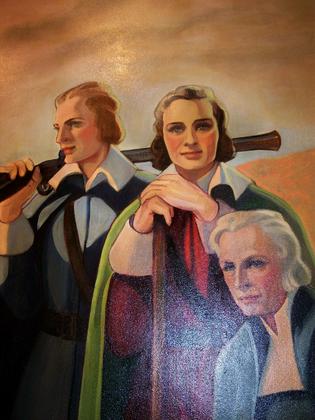 The centerpiece of the exhibit is Planning the Escape of Goffe and Whalley, a mural by Laicita Worden Gregg that was displayed for decades at the Woolsey School in Fair Haven. With vivid color and cinematic scope, the piece dramatizes New Haven’s revolutionary history”“the town’s role in the English Revolution, that is. Goffe and Whalley were two of the judges who sentenced Charles I to death and fled to the New World when the monarchy was reinstated. As shown in the mural, local residents concealed them from the authorities in a cave on West Rock.
The centerpiece of the exhibit is Planning the Escape of Goffe and Whalley, a mural by Laicita Worden Gregg that was displayed for decades at the Woolsey School in Fair Haven. With vivid color and cinematic scope, the piece dramatizes New Haven’s revolutionary history”“the town’s role in the English Revolution, that is. Goffe and Whalley were two of the judges who sentenced Charles I to death and fled to the New World when the monarchy was reinstated. As shown in the mural, local residents concealed them from the authorities in a cave on West Rock.
p(clear). 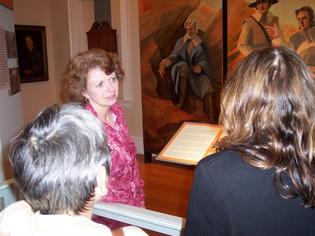 Historical themes are typical in the Federal Art Project pieces. As curator Amy Trout (pictured) explained, “These subjects were chosen to tap into civic pride during an extremely difficult time for the community.” The style of the mural was clearly chosen to appeal to contemporary taste: “They were painted to look like old movie stars.”
Historical themes are typical in the Federal Art Project pieces. As curator Amy Trout (pictured) explained, “These subjects were chosen to tap into civic pride during an extremely difficult time for the community.” The style of the mural was clearly chosen to appeal to contemporary taste: “They were painted to look like old movie stars.”
p(clear). 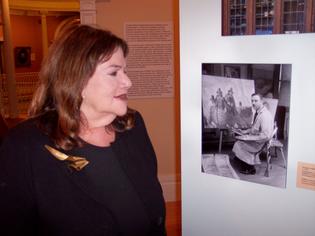 Not all the publicly funded art focused on local history. In 1935, Hamden native and painter Salvatore DeMaio earned $500 for a project that took him to Cuba. His daughter, Tish DeMaio Lattamzi, recounted the tale as she inspected photos of her father and The Battle of Santiago, the mural he had researched in Cuba. “Consider what five hundred dollars meant during the Depression. There were no jobs,” she reflected.
Not all the publicly funded art focused on local history. In 1935, Hamden native and painter Salvatore DeMaio earned $500 for a project that took him to Cuba. His daughter, Tish DeMaio Lattamzi, recounted the tale as she inspected photos of her father and The Battle of Santiago, the mural he had researched in Cuba. “Consider what five hundred dollars meant during the Depression. There were no jobs,” she reflected.
p(clear). 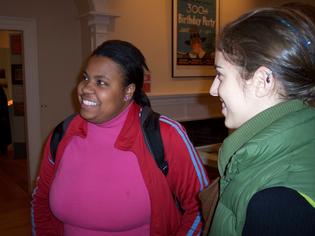 Ultimately, the exhibition opening offered New Haven more than a chance to reflect on its public art past. Zarinah Hameen (left) and Sophia Emigh came to the exhibition looking for ideas as they organize a program for high school students to paint murals advocating nonviolence. Both women work for local organizations under the auspices of Americorps service. They listened as Amy Trout cautioned that the Federal Arts Project’s success was not guaranteed from the start.
Ultimately, the exhibition opening offered New Haven more than a chance to reflect on its public art past. Zarinah Hameen (left) and Sophia Emigh came to the exhibition looking for ideas as they organize a program for high school students to paint murals advocating nonviolence. Both women work for local organizations under the auspices of Americorps service. They listened as Amy Trout cautioned that the Federal Arts Project’s success was not guaranteed from the start.
p(clear). 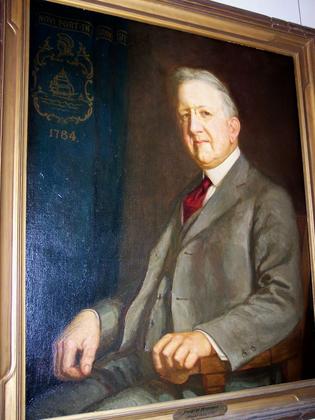 “It was really important that the city buy into the project, or there would have been no art worth displaying.” After all, there were no project funds to pay for expensive supplies like stone, canvas and paint. New Haven’s Depression era Mayor John William Murphy certainly believed that the project was good for the city. In 1933, he bought the paints and the canvas for the first painting created under the fledgling project: a portrait of himself.
“It was really important that the city buy into the project, or there would have been no art worth displaying.” After all, there were no project funds to pay for expensive supplies like stone, canvas and paint. New Haven’s Depression era Mayor John William Murphy certainly believed that the project was good for the city. In 1933, he bought the paints and the canvas for the first painting created under the fledgling project: a portrait of himself.